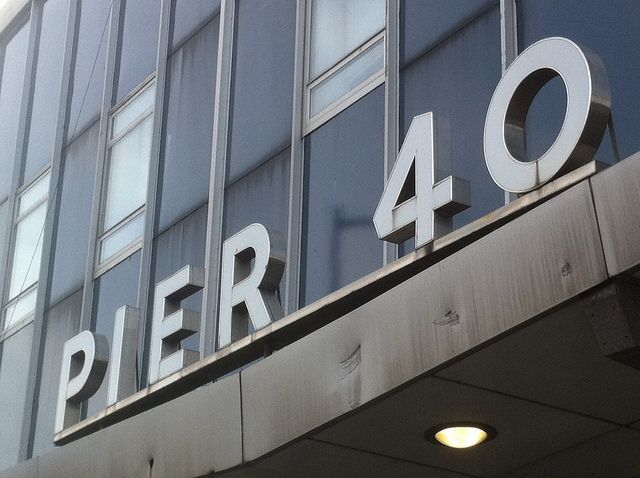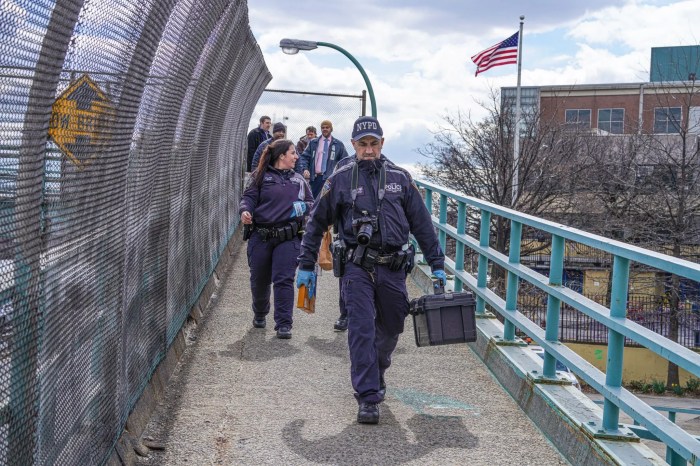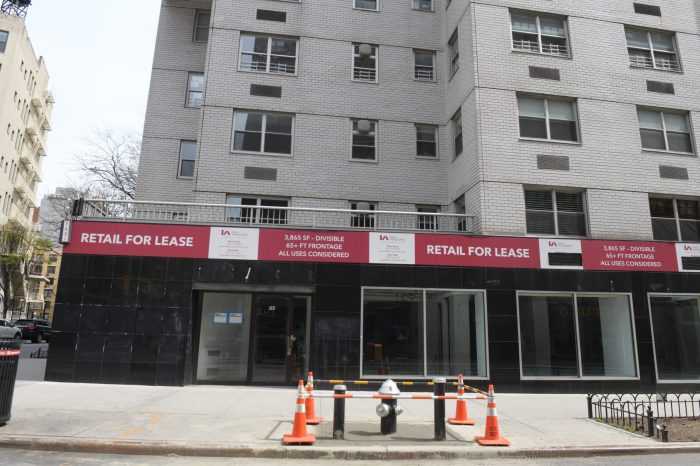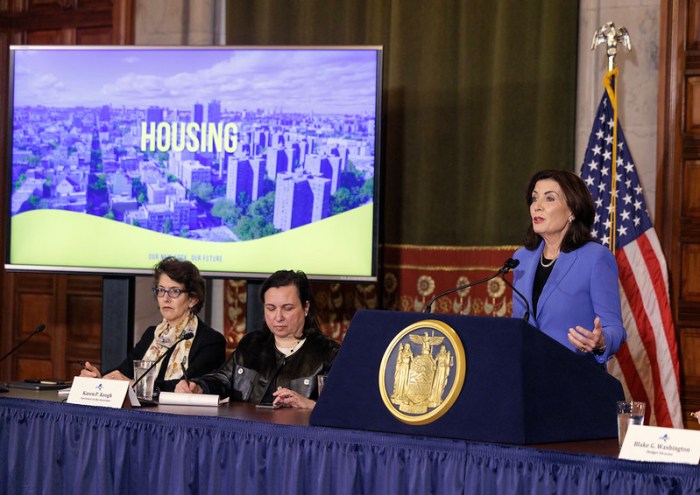BY LINCOLN ANDERSON | With nearly half of Pier 40’s rooftop deck in deteriorated condition, threatening the loss of parking revenue and the pier’s eventual shutdown, the Hudson River Park Trust’s board of directors has voted to authorize a partial renovation job for the aging, concrete-and-steel structure.
Meanwhile, a new idea for the pier’s redevelopment could emerge in about a year, following completion of a “holistic” study that would consider potential impacts on the pier’s various user groups. But until then, the pier is in sore need of some fixing.
Madelyn Wils, the Trust’s C.E.O. and president, and Daniel Kurtz, the Trust’s C.F.O. and executive vice president of finance and real estate, made the case for the long-overdue repairs at the Trust’s board meeting on Thurs., Jan. 26.
Covering 14 acres, Pier 40, at W. Houston St., is the Hudson River’s largest pier. It’s become a treasured resource for local youth sports leagues, which heavily use its gargantuan, artificial-turf, courtyard field for their baseball and soccer games.
The pier never received proper upkeep over the decades when it was previously run by the Port Authority and state Department of Transportation, Wils and Kurtz said, and now the situation must be addressed.
The Trust, the state-city authority that is building and operating the 5-mile-long waterfront park, has tried twice before to find developers to do a major overhaul of the pier, but failed each time. Those efforts — in which the Trust issued requests for proposals (R.F.P.’s) from developers — drew ideas ranging from the world’s largest oceanarium to a glitzy Cirque du Soleil entertainment complex pitched by The Related Companies that critics dubbed “Vegas on the Hudson.” The R.F.P. processes were sunk by a combination of community opposition, a weak economy and the Hudson River Park Act legislation that restricts the pier’s lease to 30 years, making it hard for big projects to be financially feasible. The Related Companies wanted the legislation amended to allow a longer-term, 49-year lease.
The pier has paid parking on three levels, which nets about $5 million a year in revenue for the Trust. Under its legislation, Hudson River Park is supposed to be self-sustaining. The park act terms Pier 40 a “commercial node,” meaning it’s expected to generate revenue, and the parking, in fact, brings in about half the park’s annual operating budget. If the rooftop deck’s condition isn’t addressed, this key revenue stream would be cut off, Wils and Kurtz said.
Furthermore, if the fixes aren’t made, the whole pier would eventually have to be shut down for safety reasons, they said.
“The sports field would ultimately go out of use,” Kurtz warned.
The Trust commissioned a study of the rooftop deck’s condition last March. At that time, they suspected only about 10 percent of the roof was in bad shape. However, when the study was completed in July, it showed that, due to years of water infiltration, actually 40 percent of the concrete planks composing the roof were in poor condition. A slide displayed at the Trust’s meeting showed red squares marking the roof’s deteriorated slabs, making the pier look like a gigantic red-and-white checkerboard.
Some of the damaged slabs can be repaired, but others need to be replaced completely, Kurtz said.
There are three options, he said: doing repairs, shoring or nothing. Shoring up the weakened slabs wouldn’t improve the pier’s value, he noted — and, as with repairs, it would still force the closure of parts of the pier while the work is being done. Kurtz called shoring “incredibly expensive,” costing $100 per square foot, amounting to $1.5 million per year over six years.
On the other hand, the slab-replacement job, as Kurtz explained it, would focus on 22 percent to 25 percent of the rooftop deck, specifically the northeastern corner, and would cost more than $6 million. Wils noted that this money would have to come from the Trust’s reserve fund, since public money from the state and city for the park has dwindled in recent years. Fixing all of the pier’s eroding rooftop concrete slabs would cost $26 million to $30 million, but the Trust doesn’t have enough in its reserve fund to cover that, she said.
Larry Goldberg, a Trust board member, expressed concern about dipping into the special account.
“That’s our reserve fund,” he warned. “We’re not getting another reserve fund for the park.”
However, Wils assured the extent of the work would be limited.
“I feel strongly that if we spend this money, this should be the only money that we spend on this roof,” she said.
“We are reaching the end of the road on what we can do to save Pier 40,” Wils said of the crumbling former shipping berth. “We can’t continue to put money into this facility with no promise of future development. This gives us another year — and after a year, we’re going to have to decide what we want to do.”
As for Pier 40’s long-term future, HR & A, a real estate and economic consulting firm, is currently studying the options, Wils said.
“We are going to work hard over the next year to come up with a solution for Pier 40,” Wils said.
Diana Taylor, chairperson of the Trust’s board of directors, said the cost of fixing and stabilizing the pier was a major obstacle for its redevelopment in the past two failed R.F.P. processes.
“What the developers were going to do was to repair Pier 40, which means they had a huge nut to cover,” she said.
Regarding the roof repair, Taylor said, “All we’re trying to do is to preserve an income stream until we find someone to do something with the pier. … This task force is working really hard to come up with something that is acceptable to people and that will earn us some income.”
If a redevelopment plan for the pier is, in fact, eventually chosen, the Trust officials said, it could take up to five years, including completion of a ULURP, until work would be ready to start.
Former Parks Commissioner Henry Stern, a member of the authority’s board, said there are two issues that make Pier 40 such a challenge. First, is the fact that the park must be self-supporting financially.
“Central Park wouldn’t have been built if it had to be self-supporting,” he stated.
Second, he said, the decision “is influenced by what the surrounding Village community wants. Their views aren’t typical of the whole city. … It seems to me — it’s impossible,” he said of the Pier 40 dilemma. “Whatever is done, Villagers are likely to object.”
But Wils said she’s “optimistic” a solution will be found.
“I wouldn’t have taken this job otherwise,” she stated.
Questioned after the meeting on whether the Trust would, in fact, at some point, issue a new R.F.P. for Pier 40, Wils, again, indicated something would be done “in a year” — but assured that nothing will happen until HR & A’s Pier 40 study is finished.
The study will look at how development plans would impact the pier’s various users.
“There’ll be no R.F.P. until then,” she said. “We’re going to take a holistic view of the pier and its users. I am putting my hopes in the study that it will come up with an idea.”
Meanwhile, a task force is looking at the whole park and ways to raise more funds for it. This group includes representatives of elected officials whose districts contain the park, members of local community organizations and the Municipal Art Society. Wils said the task force will present its recommendations in the spring.
In a fiscal double whammy, while public funds for the park have recently tapered off, the amount of Hudson River Park’s actual park space has doubled in the past three years, putting pressure on the Trust to ensure it has adequate operating funds.
In a subsequent phone call, Vivian Liao, a Trust spokesperson, said the slab-replacement work for Pier 40 should be completed by the end of this year, but could stretch into spring 2013. A contract for the work will be issued in the next couple of weeks. Then the new concrete planks will be fabricated off site, which will take about two or three months. May will see the setup of construction equipment at the site.
Fixing one-quarter of the roof will allow the Trust to preserve its revenue stream, Wils said, adding that some parking space can also be shifted to the pier’s ground-level floor.
Kurtz said repairing the roof’s northeastern corner is the best choice since these slabs are in some of the poorest condition — plus, it would work the best logistically. A crane would be located on the upland part of the park and a sidewalk-style protective shed erected to protect joggers passing underneath. On the other hand, trying to fix the deck on the pier’s western edge, for example, would mean the crane would have to be either placed on the ball field — which would mean closing the ball field — or on a barge.
Wils said the hope is to install a ramp in the pier’s northeast corner to serve the parking in the repaired roof section.
The smaller sports field on the southeastern corner of Pier 40’s roof would be able to stay open during the work.
In their report to the board members, Kurtz and Wils recommended the project should include a longer-lasting, 20-year waterproofing membrane to protect the repaired roof section. Goldberg queried them on the cost of the less-expensive option — which would offer 10 years’ protection — and Kurtz said it was about $360,000.
The Trust board voted last Thursday to approve the Pier 40 slab-replacement work, and will vote later on which membrane to use.
Another infrastructure concern, though not as pressing as the rooftop deck, is the condition of the metal support piles on which Pier 40 sits. Wils noted that the pier has 3,700 piles, 1,400 of which need to be repaired within the next five to 10 years. The remainder can be fixed in the following 10-to-15 years, she said. The pile work would cost $80 million total over the next 30 years.
In other park matters, the board voted to authorize an $895,000 contract to retain an outside legal firm to represent the Trust in a lawsuit filed by Chelsea Piers’ management over a dispute on pile maintenance and repairs.


















